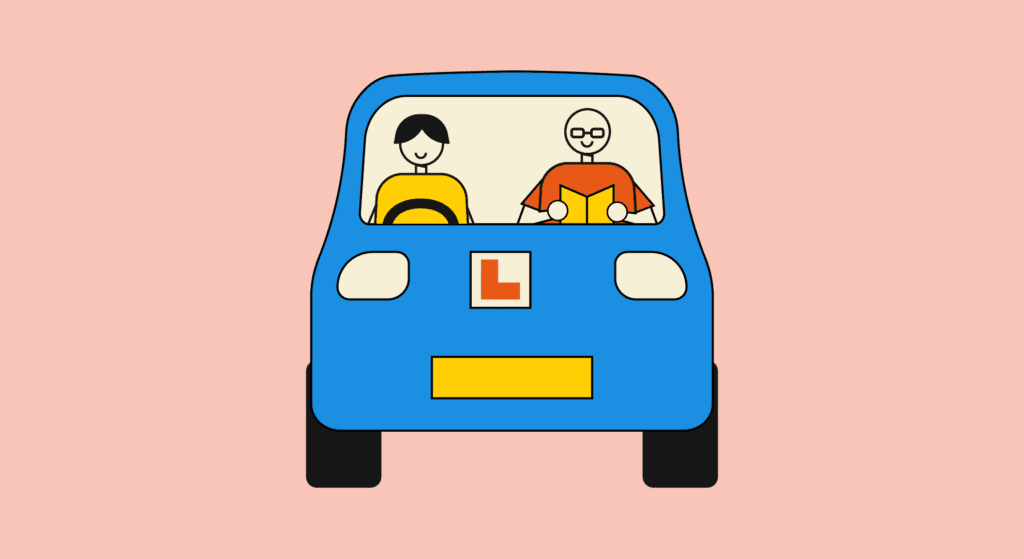‘Show me, tell me’ questions on your driving test can cause all sorts of nerves and problems and give rise to countless supplementary questions from learners. This blog answers all your questions and queries about the topic.
What are ‘show me, tell me’ questions?
A ‘show me’ question is where you show how you’d carry out a safety task while driving and a ‘tell me’ question is where you explain how you’d carry out a safety task at the start of your test, before you start driving.
How many ‘show me, tell me’ questions are there?
There are seven ‘show me’ questions and 14 ‘tell me’ questions that could be asked during your practical driving test but the examiner will only ask one of each.
What are the ‘show me’ questions?
1. When it’s safe to do so, can you show me how you wash and clean the rear windscreen?
2. When it’s safe to do so, can you show me how you wash and clean the front windscreen?
3. When it’s safe to do so, can you show me how you’d switch on your dipped headlights?
4. When it’s safe to do so, can you show me how you’d set the rear demister?
5. When it’s safe to do so, can you show me how you’d operate the horn?
6. When it’s safe to do so, can you show me how you’d demist the front windscreen?
7. When it’s safe to do so, can you show me how you’d open and close the side window?
What are the ‘tell me’ questions?
1. Tell me how you’d check that the brakes are working before starting a journey
Brakes should not feel spongy or slack. They should be tested as you set off and the vehicle should not pull to one side.
2. Tell me where you’d find the information for the recommended tyre pressures for this car and how tyre pressures should be checked
Manufacturer’s guide and use a reliable pressure gauge. You should check and adjust pressures when the tyres are cold. Don’t forget the spare tyre and remember to refit valve caps.
3. Tell me how you make sure your head restraint is correctly adjusted so it provides the best protection in the event of a crash
The head restraint should be adjusted so the rigid part of the head restraint is at least as high as the eye or top of the ears, and as close to the back of the head as is comfortable. It’s worth remembering that some restraints might not be adjustable.
4. Tell me how you’d check the tyres to ensure that they have sufficient tread depth and that their general condition is safe to use on the road
There should be no cuts and bulges, at least 1.6mm of tread depth across the central three-quarters of the breadth of the tyre, and around the entire outer circumference of the tyre.
5. Tell me how you’d check that the headlights and tail lights are working. You don’t need to exit the vehicle
Tell the examiner that you’d operate the switch (turn on ignition if necessary), then walk around the vehicle (you don’t need to physically check the lights).
6. Tell me how you’d know if there was a problem with your anti-lock braking system
The warning light should illuminate if there is a fault with the anti-lock braking system.
7. Tell me how you’d check the direction indicators are working. You don’t need to exit the vehicle
You’d operate the switch (turn on ignition if necessary), and then walk around the vehicle .
8. Tell me how you’d check the brake lights are working on this car
Say you’d operate the brake pedal, make use of reflections in windows or doors, or ask someone to help.
9. Tell me how you’d check the power-assisted steering is working before starting a journey
If the steering becomes heavy, the system may not be working properly. Before starting a journey, two simple checks can be made By applying gentle pressure on the steering wheel, once the engine has been turned on, there should be a slight but noticeable movement as the car begins to operate.Or, turning the wheel after moving off will give an indication that the power assistance is functioning.
10. Tell me how you’d switch on the rear fog light(s) and explain when you’d use them. You don’t need to exit the vehicle
Operate the switch and check the warning light is on. You can turn on the ignition and dipped headlights if necessary.
11. Tell me how you switch your headlight from dipped to main beam and explain how you’d know the main beam is on
Check the main beam light is on by operating the switch with the car running if necessary.
Operate switch (with ignition or engine on if necessary), check with main beam warning light.
12. Open the bonnet and tell me how you’d check that the engine has sufficient oil
Identify the dipstick/oil level indicator and describe how you’d check the oil level against the minimum and maximum markers.
13. Open the bonnet and tell me how you’d check that the engine has sufficient engine coolant
Identify high and low-level markings on the header tank where fitted or radiator filler cap. Describe how to top it up to the correct level.
14. Open the bonnet and tell me how you’d check that you have a safe level of hydraulic brake fluid
Identify the reservoir and check the level against high and low markings.
You need to open the bonnet and tell the examiner how you’d do the check if you’re asked question 12, 13 or 14.
Are ‘show me, tell me’ questions minors?
If you get a ‘show me, tell me’ question wrong, the examiner will regard your mistake as a minor error.
Can you fail on show me, tell me questions?
If you get a ‘show me, tell me’ question wrong, you’ll receive a fault but this won’t automatically result in you failing your driving test. You are allowed up to 15 minor faults before the examiner will fail you.
That means you could still pass your test even if you get both ‘show me, tell me’ questions wrong – though it may knock your confidence and impact on your later driving if you do!
Is it easy to remember ‘show me, tell me’ questions?
The simple fact is, preparation is key. There are a limited number of questions so make sure you know the answers. You will remember them better the more often you practise them. Your driving instructor knows the questions too so they will coach you through them.
If you are getting extra practice in a car belonging to a family member or friend, ask them to quiz you on them too.
Get specialist learner driver insurance
Adrian Flux offers flexible learner driver insurance which can be purchased annually, monthly or daily, depending on your needs. Prices start from 65p a day.
Call 0800 369 8590 for a swift quote. Our best deals are usually obtained over the phone – 81.5% of all customers receiving an online quote in August 2022 could have obtained a cheaper quote over the phone.

